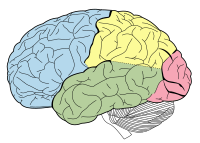
Photo from wikipedia
People with severe physical disabilities are not able of using standard robotic wheelchairs, which generally demand some motor skills, and therefore total usage of associate muscles. Robotic wheelchairs commanded by… Click to show full abstract
People with severe physical disabilities are not able of using standard robotic wheelchairs, which generally demand some motor skills, and therefore total usage of associate muscles. Robotic wheelchairs commanded by brain-computer interfaces (BCIs) based on electroencephalography have demonstrated to be an alternative for these end-users. In general, existing robotic wheelchairs commanded by BCIs require special platforms adapted to the EEG-BCI, and end-users need to attend a long training process to safely drive these devices. But many times these potential users do not have access to training sessions; due to mobility problems or technology access restrictions. This study proposes an EEG-based BCI with a customizable configuration to be used in cloud architectures for the remote control of robotic wheelchairs. This research explores two types of steady-state visual evoked potential (SSVEP)-based BCI by applying canonical correlation analysis (CCA) and compressive sensing (CS) as a novelty, adopting one free calibration, and the other including a calibration stage. The free-calibrated SSVEP recognition approach (CS-ncCCA) using compression ratio (CR) at 60% obtained accuracy (ACC) of 85% and information transfer rate (ITR) of 102 bits per minute (b/min), whereas the calibrated BCI (CS-wcCCA) applying also CR at 62% achieved ACC of 85% and ITR of 195 b/min. As a highlight, the proposed BCI allows a significant reduction of the transmitted file size (TFS) and improves the communication latency that may be useful in remote and cloud robotics applications, such as for users with severe motor disabilities, to train driving safely robotic wheelchairs via Internet of Things (IoT).
Journal Title: IEEE Transactions on Instrumentation and Measurement
Year Published: 2022
Link to full text (if available)
Share on Social Media: Sign Up to like & get
recommendations!